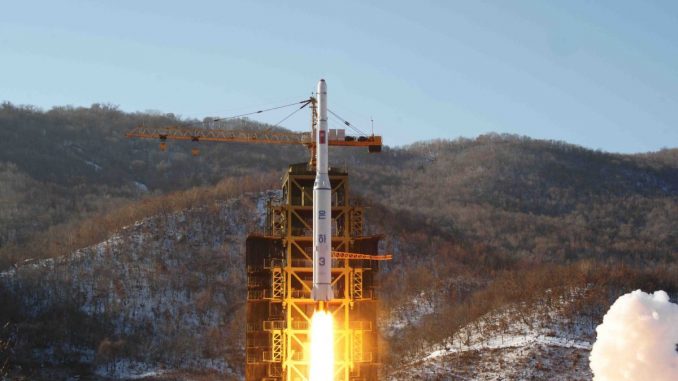
North Korea’s version of NASA aims to send more satellites into orbit in the next few years and is planning on a moon mission within the next 10 years.
DPRK space officials have a five-year plan to launch more advanced satellites into orbit by 2020 and are working to put a man on the moon and explore other planets.
Toronto Star reports:

BYPASS THE CENSORS
Sign up to get unfiltered news delivered straight to your inbox.
You can unsubscribe any time. By subscribing you agree to our Terms of Use
Latest Video
In an interview with The Associated Press, a senior official at North Korea’s version of NASA said international sanctions won’t stop the country from launching more satellites by 2020, and that he hopes to see the North Korean flag on the moon within the next 10 years.
“Even though the U.S. and its allies try to block our space development, our aerospace scientists will conquer space and definitely plant the flag of the DPRK on the moon,” said Hyon Kwang Il, director of the scientific research department of North Korea’s National Aerospace Development Administration.
North Korea’s official name is the Democratic People’s Republic of Korea.
An unmanned, no-frills North Korean moon mission in the not-too-distant future isn’t as far-fetched as it might seem. Outside experts say it’s ambitious, but conceivable. While the U.S. is the only country to have conducted manned lunar missions, other nations have sent unmanned spacecraft there and have in that sense planted their flags.
“It would be a significant increase in technology, not one that is beyond them, but you have to debug each bit,” Jonathan McDowell, an astrophysicist at the Harvard-Smithsonian Center for Astrophysics who maintains an exhaustive blog on international satellites and satellite launches, said in an email to The Associated Press.
Hyon said the current five-year plan, at the order of leader Kim Jong Un, focuses on launching more Earth observation satellites and what would be its first geostationary communications satellite — which, technologically, would be a major step forward. He said universities are also expanding programs to train rocket scientists.
“We are planning to develop the Earth observation satellites and to solve communications problems by developing geostationary satellites. All of this work will be the basis for the flight to the moon,” Hyon said on July 28, adding that he personally would like to see that happen “within 10 years’ time.”
North Korea has marked a number of successes in its space program — and, of course, in its development of ever-more-sophisticated long-range missiles for military use. On Wednesday, it test-fired what was believed to be a medium-range ballistic missile into the seas off Japan, the fourth reported weapons launch it has carried out in about two weeks.
It launched its latest satellite — the Kwangmyongsong 4, or Brilliant Star 4 — into orbit on Feb. 7, just one month after conducting what it claims was its first H-bomb test.
That brought new sanctions because nuclear tests and rocket launches, which can have military applications, are banned under United Nations resolutions.
Hyon said the sanctions are “ridiculous.”
“Our country has started to accomplish our plan and we have started to gain a lot of successes,” he said. “No matter what anyone thinks, our country will launch more satellites.”
He said North Korea’s long-term target is to use its satellites to provide data for crop and forestry assessments and improved communications. It also intends “to do manned space flight and scientific experiments in space, make a flight to the moon and moon exploration and also exploration to other planets.”
The U.S. made its first lunar flyby in 1959, only six months after its first satellite, Explorer 1, though it took eight more years and several failed attempts to succeed with a lunar orbiter. The USSR made its first moon shot after only three successful Sputnik satellites. Its probe — just a year and a half after Sputnik 1 — reached the moon, but missed its orbit.
“So it’s not ridiculous to attempt a moon mission early in your space program,” McDowell said.
“Given their low flight rate of one mission every few years, I think it is hard to see them succeeding in this in the next five years, but possible to see them attempting it,” he said.
North Korea currently has two satellites in orbit, KMS-3-2 and KMS-4. It put its first satellite in orbit in 2012, a feat few other countries have achieved. Rival South Korea, for example, has yet to do so.
Hyon said that as of July 27, KMS-4 had completed 2,513 orbits, and that within one day after its launch it transmitted 700 photographic images back to Earth. He said it is still working properly and sending data whenever it passes over North Korea, which is four times a day.
Foreign experts have yet to confirm any communications from the satellite.
“There’s been no independent evidence that KMS-4 sent data back, but no evidence that it didn’t, either,” McDowell said.
German analyst Markus Schiller, one of the world’s foremost experts on North Korea’s missiles and rockets, said a geostationary satellite might be a more ambitious goal for the country than a lunar flyby or crash-landing.
“Hitting the moon hard would require less performance — power, rocket size — than getting into GEO (geostationary equatorial orbit), but it will still be quite a challenge,” he said in an email from Munich, where he is based.
“Judging from what I have seen so far with their space program, it will take North Korea about a decade or more to get to lunar orbit at best — if they really pursue this mission,” he said. “My personal guess, however, is that they might try but they will fail, and we will not see a successful North Korea lunar orbiter for at least two decades, if ever.”



